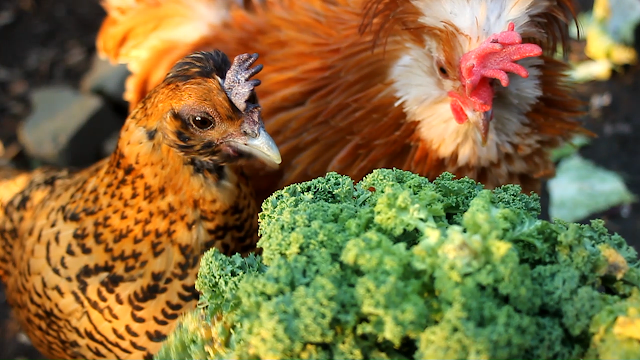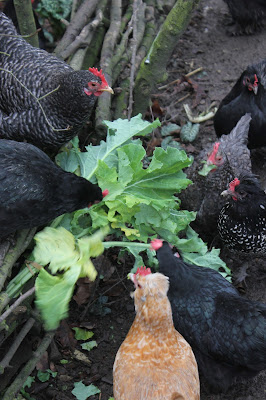I'll start this article with a dip into literature. I think this is very important in the understanding of both why I treat a bird holistically and also as an illustration of how society has changed and been influenced by modern medicine.
In her Book of Household Management, first published in 1861, Mrs Beeton referred to:
'The diseases to which Gallus domesticus is chiefly liable are, arc roup, pip scouring and chip.....The first-mentioned is the most common of all, and results from cold. The ordinary symptoms, - swollen eyes, running at the nostrils, and the purple colour of the wattles.'
 Similarly, Hugh Piper in his comprehensive book; Profitable and Ornamental Poultry A Practical Guide, first published in 1871, referred to roup as;
Similarly, Hugh Piper in his comprehensive book; Profitable and Ornamental Poultry A Practical Guide, first published in 1871, referred to roup as; '...caused by exposure to excessive wet or very cold winds. It begins with a slight hoarseness and catching of the breath as if from cold, and terminates in an offensive discharge from the nostrils, froth in the corners of the eyes, and swollen lids. It is very contagious.'
What we are actually talking about here is the common cold, or rather the symptoms of it and in poultry this is sometimes referred to as coryza or interchangeably as catarrh and/or rhinitis. What is interesting though, is that if you dig more deeply into this condition you will see in organic and small backyard flocks it is mostly seasonal and often triggered by allergy (hence damp, musty, dusty mouldy, environments) and/or stress (hence continued periods of low temperatures).
Despite the words above, i.e. Piper's, 'very contagious' I see this as no reason to panic. To me this just means that because many chickens live in flocks, roost together, share drinkers and food bowls, they are apt to pass on the 'offensive discharge'. However, this does not imply, they will all succumb. What I believe is referred to here is a secondary infection due to the bird's nostril becoming infected when the detox through the nose is not free-flowing. Blackened, blocked nostrils with an accompanying unpleasant smell are the tell-tale sign of this infection.
The above symptoms can also be caused by an initial bacterial infection. In my experience of germ theory, bacteria (in this case strains of Haemophilus paragallinarum), are like the poor, always with us. It is directly related to our immune systems, general health, food, emotional state, environment and behaviour as to how and if we are affected by their presence.
As I suppose was to be expected, Haemophilus paragallinarum (now known as Avibacterium paragallinarum), was first identified at the beginning of the 20th century, prior to WW1 and around the time of the first experiments with industrial, intensive farming. The interest in the bacteria and its management was no doubt occasioned by the significant drop in egg production caused by its passage and also the fact that it needed close contact (and stress) to spread.
So, What is it and How do we treat it
Whatever name you wish to call it, roup is as good as any, coming it is presumed from the Middle English for to shout or cry out, roupen and the Old Norse hrŏpa of similar meaning. If you've ever heard a bird with a roupy cough then you'll know how apt this is. Whether caused by environmental factors, secondary infection or Haemophilus paragallinarum, roup can cause inflammation of the upper respiratory tract. This is an immune system response to the condition, as well as the bacteria producing toxins which can affect the eyes, nostrils and throat. The bird's, cough, runny nose and watery eyes are its way of detoxing these poisons, this is important, when considering how to treat the condition. In essence, my task is always to help the bird to rid itself of the moulds/pollutants and/or bacteria. In other words to aid the detoxification process. Most conventional, allopathic responses are to treat with antibiotic antimicrobial agents, the overuse of these, particularly in farming, have entailed serious repercussions.
My first reaction therefore, is to keep the bird warm, in a stress-free environment and to support the immune system and in particular to avoid foods which increase mucous production and inflammation.
My first reaction therefore, is to keep the bird warm, in a stress-free environment and to support the immune system and in particular to avoid foods which increase mucous production and inflammation.
Foods for Preventing & Fighting Inflammation and Mucous Build Up
 Although mucous and inflammation both play a role in protecting the body from attack, they can become excessive and add to the problem. One of the key ways in which both can be controlled is by diet. The first thing I always do is to remove all grain albeit sprouted, from a bird's diet. I also up the level of Vitamin A and of course Vitamin C, which is one of the first nutrients to be flushed when the bird is stressed. With reference to Vitamin A, if you have read my article on scaly leg and face mite you will remember the link between Vitamin A deficiency and the over-production of keratin. The complications that this latter can produce include:
Although mucous and inflammation both play a role in protecting the body from attack, they can become excessive and add to the problem. One of the key ways in which both can be controlled is by diet. The first thing I always do is to remove all grain albeit sprouted, from a bird's diet. I also up the level of Vitamin A and of course Vitamin C, which is one of the first nutrients to be flushed when the bird is stressed. With reference to Vitamin A, if you have read my article on scaly leg and face mite you will remember the link between Vitamin A deficiency and the over-production of keratin. The complications that this latter can produce include:- sneezing and swollen sinuses due to the blocking of these cavities with excessive squamous and keratin growth.. leading potentially to
- mucus blockage and thus potential infection, allergy and/or toxicity due to the inability to remove inhaled bacteria, dust and pollutants
- laboured breathing due to similar blockages in the trachea
Thereby witness the importance of Vitamin A in this condition. Also to be considered is the need for zinc, which has been found to be
beneficial in stimulating immune system response. Furthermore, zinc also has
a role in the transportation of Vitamin A from storage in the liver for
use in the rest of the body.
There has recently been interest in researching the effect of Vitamin D3 on upper respiratory tract infections. Since this is a stored vitamin/hormone, which is created in UVB sunlight, which for example is only available to us, here in France for eight months of the year, this might be seen more of a prevention rather than a cure. However, there is a certain amount of vitamin D3 available in foods and one of the best I have found and very acceptable to my chickens, is raw organic butter from grass-fed cows. I just give a small amount, equivalent say to in a large pea/bean-size quantity. (I am in the process of compiling an article and editing a film on D3, which should be available in the coming weeks.)
Highly Coloured Fruit & Vegetables including the all important brassicas:
Cabbage contains several anti-inflammatory nutrients, including:- anthocyanins (flavenoids which make the red/blue pigment in fruit and vegetables) these are obviously more prevalent in red cabbage,
- polyphenols (antioxidants) present in abundance in all kinds of cabbage,
- the amino acid L-glutamine.
- the glucosinolate, sinigrin, which has anti-microbial properties. The Savoy cabbage I use is the one with a higher proportion of sinigrin, which is also prevalent in the seeds of another brassica, black mustard and was used historically in medicine as a 'mustard plaster'.
Coryza or Roup with Eye Problems & Facial Swelling
I have already discussed coryza associated with conjunctivitis in a previous article and in which I give the herb Euphrasia as one of my tried and tested remedies This includes treating myself when I had conjunctivitis during my exam finals. For birds, one of the easiest and I found most effective deliveries for the herb was through homepathic pillules. The company I use, Boiron, sells Euphrasia Officinalis 6c in the USA, which I have also used here in 6ch (European). Boiron also sells Euphrasia Officinalis 5ch
in the UK too. These suggested potencies for poultry and the dosage of 3
pillules 3 times per day, were given to me by a friend who is an
organic farmer and also shadowed an organic vet as part of her training.
In the case of a really bad infection, I have followed my sister's
advice (also an organic farmer) and given 6 doses of 3 pillules in one
day. The reason being, that within 48 hours i.e. six treatments, the
patient should be responding well to treatment and looking much better.
Therefore by the sixth dose you will know if you are on the right track,
something really important in an advanced case. Also in advanced cases
you can ignore the usual advice to give homeopathy outside mealtimes,
the usual protocol is half an hour before or after food. For more complete information on using homeopathy, please refer to the 'related article' section below.
I will continue this subject in the following article where I will discuss amongst others, the use of steam inhalation for this condition. In my experience this is highly effective and one of the best natural treatments particularly when you have several birds to treat at once.
Thanks for dropping by and do feel free to share experiences or ask for further information in the comment section. If you have enjoyed this piece and found it
useful think about sharing it with your family and friends, on social media and also maybe about joining this blog
and/or subscribing to my Youtube channel or even supporting us on
Patreon or
It all helps to keep me going!Until next time, all the very best from Normandie! Sue
RELATED ARTICLES
Treating Roup/Coryza Respiratory Problems 2 Steam Inhalation
Steam inhalation is one of the oldest forms of delivery for medicines.
Evidence for its use is found in ancient Egyptian medical texts, such as
the Ebers papyrus (1,554 B.C.).....read more
 Treating eye problems & facial swelling. Assessment-Observations-Techniques.
Treating eye problems & facial swelling. Assessment-Observations-Techniques.
This is Clementina, she has a problem with swelling around both eyes and inflammation of the third
eyelid...read more
 Treating eye Problems & facial swelling. Herbal Infusions-Compresses-Eye Baths
Treating eye Problems & facial swelling. Herbal Infusions-Compresses-Eye Baths
Sharing two home-made infusions for the treatment of eyes. They are
both edible so there is no problem if your bird drinks them...read more
Scaly Leg and Face Mite Infestations Why They Happen & What To Do Part 1
I look at the correlation between specific
deficiency and parasitisation because it is fundamental to everything I
believe is wrong...read more













There is an adjustment control on the device that allows you to increase or decrease the amount of steam and size of particles as per your requirements.
ReplyDeleteGurin Steam Inhaler